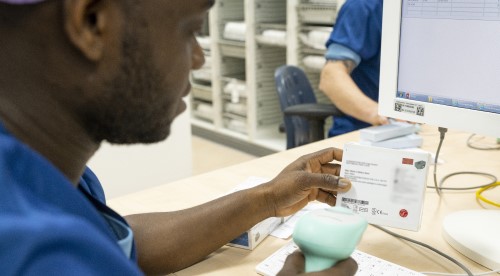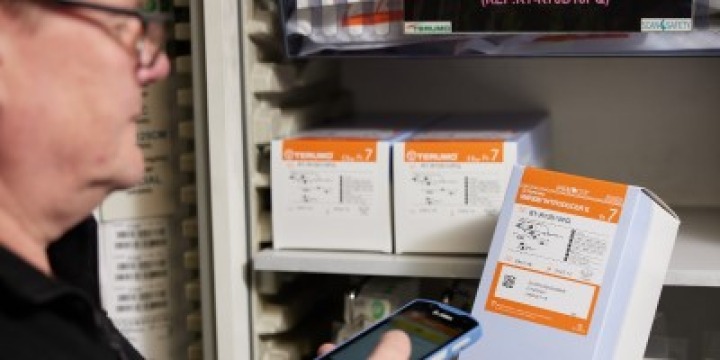Accurate identification of products and medical devices helps to improve traceability through the supply chain and patient pathway.
Packaging for products and devices include a GS1 barcode encoded with the unique identifier - the GS1 Global Trade Item Number.
This barcode is also encoded with key product information such as the batch/lot number, serial number, and date of manufacture or expiry - production identifier (PI). In GS1 terms the PI is known as the Application Identifier (AI).
When scanned at the point of care or use, the information encoded in the barcode is captured in near real time and updated in the relevant system or record.

Unique device identification (UDI)
In the case of medical devices and in-vitro diagnostic medical devices, this is known as UDI which consists of the Device Identifier (labelling organisation ID and device model details (DI)) + PI information. In GS1 terms, the GTIN is the equivalent of the DI.
Individual medical devices can then be traced through the supply chain, and importantly, directly to the patient. Supporting information on UDI can be found on the GS1 website.
GTIN adoption for UDI
Unique identification is particularly important for medical device traceability and patient safety. Many medical devices now use GS1 GTINs as the primary unique device identifier (UDI).
In a survey conducted with Portsmouth Hospitals University NHS Trust and GS1 Healthcare, we tested more than 2400 medical devices to gauge adoption.
More than 95% of the 2433 medical devices assessed use a GS1 GTIN for UDI.
More suppliers using GS1 GTINs as the primary unique device identifier than in 2018.
Use of the GS1 2D DataMatrix on product packaging has nearly doubled since 2018.
To help make sure your barcodes are right first time, we have developed a series of short webinars to take you through what you need to know. Find out more in the barcoding success bitesize series by following the link below.
Barcode scanning in hospitals
To support medical device traceability, the UK government issued a mandate to NHS England to promote the adoption of barcode scanning for high-risk medical devices.
By March 2024, NHS trusts in England will be required to implement scanning to capture accurate device information in support of the Medical Device Outcomes Registry (MDOR).

Barcode verification
Hospitals rely on being able to scan product barcodes at the point of care or use. To ensure your barcodes are accurate and follow the necessary format required for compliance, you can send us an image to check.
We will review the barcode size and quality, and will follow up with you with any feedback or recommendations. Send us an image for review via the link below.
UDI regulations
GS1 is an authorised issuing entity for UDI for many global medical device regulations. GS1 members can use GS1 GTINs to comply with necessary UDI requirements. Many medical devices now use GS1 GTINs as the primary unique device identifier.
To help improve traceability and patient safety, the EU and the US have both published UDI regulations for medical devices. These regulations join a globally harmonised framework for identification of medical devices – enhancing quality of care, patient safety and business processes. Each regulation has similar requirements that differ in places, have different timescales and use different databases for manufacturers to update.
The UK Medicines and Healthcare products Regulatory Agency (MHRA) are reviewing the UDI requirements for legislation in Great Britain.
Following the UK departure from Europe, the European Medical Device Regulation (EU MDR) and In-vitro Diagnostic Medical Device Regulations (IVDR) will not apply in Great Britain (GB). Legislation that will apply in GB will be the Medical Device Regulations 2002.
The MHRA will be using the Medicines and Medical Devices Act to improve the traceability of medicines and medical devices. By standardising the way devices are identified (using unique device identification – UDI), this will enable devices to be tracked and traced once on the market.
Device reference data will then be captured and held in a national medical device register to improve post-market surveillance. This includes: proactively monitoring device performance for re-certification, annual safety updates for higher-risk class devices, rapid reporting of safety incidents, and facilitation of efficient product recalls.
The register is intended to hold details of manufacturers and all relevant production information of devices placed on the GB market.
Registration of devices in GB are to be no later than 1 May 2021, 1 September 2021, and 1 January 2022 for relevant device classes.
Click here to read the latest updates including that the Government has made regulations that enable CE marked medical devices to continue to be accepted in Great Britain for defined periods beyond 30 June 2023
The European Union published the regulations on medical devices and in-vitro diagnostics in April 2017. Original dates listed have since been updated to the timelines outlined below as highlighted in the European Commission's Unique Device Identification (UDI) System – FAQs document.
Compliance timelines in the EU
| Class of device | UDI assignment | Submission of UDI | UDI carrier placem |
|---|---|---|---|
| Implantable devices and Class III devices | 26 May 2021 | See below | 26 May 2021 |
| Class Ila and Class llb devices | 26 May 2021 | See below | 26 May 2023 |
| Class I devices | 26 May 2021 | See below | 26 May 2025 |
| Reusable devices that shall bear the UDI Carrier on the device itself | 26 May 2021 | See below | 2 years after the date applicable for its respective class of devices |
| Class D IVDs | 26 May 2022 | See below | 26 May 2023 |
| Class C and B IVDs | 26 May 2022 | See below | 26 May 2025 |
| Class A IVDs | 26 May 2022 | See below | 26 May 2027 |
The release of EUDAMED modules
The European Commission (EC) has officially confirmed that the EUDAMED UDI/Devices registration, and Notified Bodies and Certificates modules have been successfully deployed in the Production environment and are now available for use. The remaining modules will be displayed as soon as they are functional.
*There will be a gradual roll-out of EUDAMED modules. The first of which could become mandatory soon after they are audited and declared functional, which is expected in 2025.
- Actors module (actors shall register within 6 months after the module is declared fully functional)
- UDI/Devices module (devices should be registered within 12 months after the module is declared fully functional)
- Notified Bodies/Certificates module (Certificates should be uploaded within 18 months after the module is declared fully functional)
Latest news (updated as of August 2024):
The swissdamed Actors module went live on 6 August 2024.
For more information about swissdamed and using the newly live Actors module, see swissmedic's website here.
Latest news (updated as of May 2024):
The Council of the European Union endorsed the European Commission’s Proposal in February 2024. This involved key updates to the law on medical devices that will help prevent shortages and ease the transition to greater transparency and access to information. Further information on the update can be found here. The proposed timelines below are now instated.
Extension of the transitional period for IVDR legacy devices to the following dates:
- 31 December 2027 for Class D
- 31 December 2028 for Class C
- 31 December 2029 for Class B & A sterile
A gradual roll-out of EUDAMED modules. The first modules could become mandatory soon after they were audited and declared functional, which is expected in 2025:
- Actors module (actors shall register within 6 months after the module is declared fully functional)
- UDI/Devices module (devices should be registered within 12 months after the module is declared fully functional)
- Notified Bodies/Certificates module (Certificates should be uploaded within 18 months after the module is declared fully functional)
New EUDAMED release dates (updated as of October 2023)
- The new target date for EUDAMED full functionality is Q2 2027.
- The new target date for mandatory use of Actor module, Market Surveillance module, Vigilance module and CIPS module is Q4 2027.
- The new target date for mandatory use of Devices module (incl. UDI) and Certificates modules is Q4 2029.
You can find further information on the full EUDAMED implementation roadmap.
European Commission's UDI Helpdesk
The European Commission has launched a dedicated UDI helpdesk to support organisations with implementing the obligations and requirements of the new UDI system under regulations (EU) 2017/745 on medical devices (MDR) and (EU) 2017/746 on in vitro diagnostic medical devices (IVDR).
It has been developed to provide additional support with regards to UDI assignment, labelling and registration of devices, as well as guidance on the use of the European Medical Devices Nomenclature (EMDN).
Master UDI-DI (updated as of December 2024)
The Medical Device Coordination Group (MDCG) has published guidance on the implementation of the Master UDI-DI solution for contact lenses. This document aims to provide guidance in the implementation of Master UDI-DI rules for contact lenses as regards its structure, assignment, labelling and registration in Eudamed.
Master UDI-DI: the unique identifier used for grouping certain highly individualised devices.
Such highly individualised devices present specific similarities with respect to pre-defined clinically relevant parameters (e.g. a single Master UDI-DI should be assigned to contact lenses that have the same combination of contact lens design parameters, including at least base curve and diameter). The Master UDI-DI is the access key to device information related to a group of devices with the same intended purpose and the same principal design, stored in Eudamed. Master UDI-DI assignment should follow the rules of EU designated issuing entities. The Master UDI-DI shall be associated to a Basic UDI-DI, which shall be assigned per the MDR and MDCG 2018-1.
More information on how the Master UDI-DI is created using GS1 standards is available below.
The US Food and Drug Administration (FDA) has had a Unique Device Identification (UDI) system for medical devices sold into the US since 2013.
Compliance timelines in the US
| Deadline | Requirement |
|---|---|
| 24 September 2014 | Class III; Labels and packages of all Class III medical devices and devices listed under the Public Health Service Act must have a UDI. Data for these devices must be submitted to the Global UDI Database (GUDID). |
| 25 September 2015 | Labels and packages of implantable, life-supporting and life-sustaining devices must have a UDI. Data for these devices must be submitted to the GUDID. |
| 24 September 2016 | Class II; Labels and packages of Class II medical devices must have a UDI. Data for these devices must be submitted to the GUDID. |
| 24 September 2018 | Class I; Labels and packages of Class I medical devices that have not been classified as Class I, II or III must have a UDI. Data for these devices must be submitted to the GUDID. |
FDA Extends Alternatives UDI-A160001 and UDI-A160002
The U.S. Food and Drug Administration (FDA) has extended the following unique device identifier (UDI) alternatives UDI-A160001 and UDI-A160002.
This extension means certain non-prescription, over-the-counter devices intended to be sold exclusively through retail establishments may continue to bear a Universal Product Code (UPC) as their device identifier.
These two alternatives expire on 24 September 2023.
For more information on the alternatives and a list of the FDA product codes to which the alternatives apply, click "learn more" below, to go to the FDA Decisions section of the UDI Exceptions, Alternatives, and Time Extensions page on FDA.gov.
If you have any further questions, contact the FDA UDI Help Desk via the link below.




